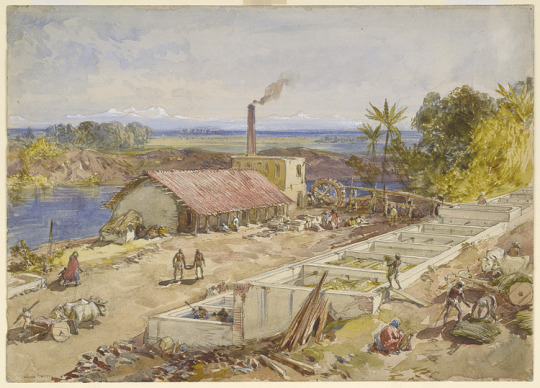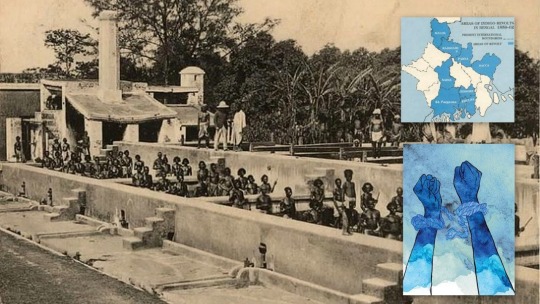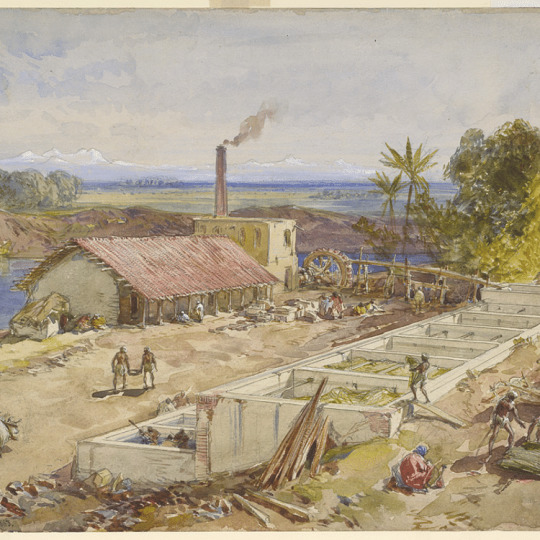#IndigoRevolt
Photo

Indigo Revolt
The Indigo Revolt (aka Indigo Riots or Blue Mutiny) of 1859-60 in Bengal, India, involved indigo growers going on strike in protest at working conditions and pay. The subsequent violence was aimed at exploitative European plantation owners, but the cause was, during and after, taken up by anti-colonial Indian liberals as an example of the necessity for independence.
The Indigo Trade
India was known for its cotton textiles through the Middle Ages, and by the mid-16th century Gujarat in northwest India was major a source of indigo, the deep blue-violet dye used to colour cotton and other materials. Indigo was in high demand by the European trading companies, including the British East India Company (EIC) which made large profits from its export. The EIC used well the long-standing expertise of Indian indigo growers and dyers, particularly in centres such as Sarkhej in Gujarat and Bayana in neighbouring Rajasthan, both in northeast India.
The making of indigo dye was a long and labour-intensive process. The plant cuttings were harvested once a year in June or July before the onset of the rainy season. These were then taken to a factory by cart where they were emptied into large vats to steep in water. The dyed water and mash was then boiled as this brought out a richer colour in the indigo grains, which then had to be strained out. The grains were next pressed into dried cakes, which were in turn pressed into barrels or, alternatively, the mass was cut into cubes and packed into chests ready for transportation. Most indigo was shipped to Calcutta (Kolkata) for sale to merchants who then organised shipment to England or the Americas where it was used to colour textiles. From the late 18th century, Bengal became the major centre for indigo production, accounting for 67% of London's total imports of the dye in 1796 (around 2 million kilograms) and then rising further into the 19th century.
The indigo industry was a volatile one. Too much or too little rain greatly affected the quantity and quality of the dye produced each year, and in boom years, overproduction brought a crash in the price. Still, for the long-term investor, indigo could be a very lucrative industry indeed. Unfortunately, the financial speculation that resulted in such a crop with potential for large gains was another source of instability. Finally, the location of many indigo plantations made them prone to flooding, which not only damaged the crop but often swept away the factory facilities.
Continue reading...
22 notes
·
View notes
Photo

नील विद्रोह ; किसानो द्वारा पहला आंदोलन
कई बार देखने में आता है की भारत का वो हिस्सा जिस पर सारे देश के पालन और पोषण का ज़िम्मा है हम उन लोगो को हाशिये पर रख देते हैं। भारत की आज़ादी की लड़ाई में जितनी भूमिका नेताओ और आम नागरिको ने निभाई है वही किसानो ने भी इसमें बढ़ चढ़ कर हिस्सा लिया है।
क्यों पड़ी किसानो को आंदोलन की ज़रूरत ?
किसान अंग्रेज़ो की शोषक नीतियो से बहुत ही ज़्यादा तंग आ चुके थे।भारत की औपनिवेशिक नीतियों ने भारत के कृषि क्षेत्र को पूरी तरह से बदल दिया।अंग्रेज़ों द्वारा अपनाई गई भूमि राजस्व नीति के चलते किसानो को अधिक किराया देना पड़ता था।ज़मींदारो को पूर्ण रूप से शक्ति दे दी गई थी और साहूकारो का भी दख़ल हो चला था। जब किसान समय पर सरकार को पैसा नहीं दे पाते थे तो वह पैसा ब्याज पर लेने साहूकारों के पास जाते थे और किसानो की मजबूरी का नाजायज़ फायदा उठाते हुए साहूकार भी उनसे दुगना ब्याज वसूल करते थे। किसान पैसे ना चुका पाने के कारण बेरोज़गार होते गए और ज़मीन से हाथ धोते गए। इस ही कारण किसान केवल एक मज़दूर बन कर रह गए और यही कारण था की किसानो द्वारा भारत के अलग- अलग राज्यों में आंदोलन होने लगे।
नील विद्रोह :
नील विद्रोह किसानो द्वारा पहला आंदोलन था जो की 1859 में बंगाल के नादिया ज़िले में दिगंबर ब��स्वास और बिष्नु बिस्वास के नेतृत्व में हुआ।
कारण :
1777 में बंगाल में नील की खेती शुरू हुई।
नीलदुनिया भर में उच्च मांग में थी। यूरोप में नीली डाई की मांग के कारण नील में व्यापार आकर्षक था।
यूरोपीय प्लांटर्स ने इंडिगो पर एकाधिकार का आनंद लिया और उन्होंने भारतीय किसानों को उनके साथ धोखाधड़ी वाले सौदों पर हस्ताक्षर करके नील उगाने के लिए मजबूर किया।
खेती करने वालों को खाद्य फसलों के स्थान पर नील उगाने के लिए मजबूर किया गया था।
वे इस उद्देश्य के लिए उन्नत ऋण थे। एक बार जब किसानों ने ऋण लिया, तो वे ब्याज की उच्च दरों के कारण इसे कभी नहीं चुका सकते थे।
कर की दरें भी बहुत कम थीं।
किसानों को बेरहमी से प्रताड़ित किया जाता था यदि वे किराया नहीं दे सकते थे या प्लांटर्स के कहने पर करने से मना कर देते थे।
उन्हें गैर-लाभदायक दरों पर नील बेचने के लिए मजबूर किया गया ताकि यूरोपीय बागान मालिकों के मुनाफे को अधिकतम किया जा सके।
यदि किसी किसान ने नील उगाने से इनकार कर दिया और उसके बदले धान लगाया, तो बागवानों ने किसान को नील
उगाने के लिए अवैध साधन का सहारा लिया जैसे कि लूट और फसल जलाना, किसान के परिवार के सदस्यों का अपहरण करना आदि।
सरकार ने हमेशा बागवानों का समर्थन किया जिन्होंने कई विशेषाधिकार और न्यायिक प्रतिरक्षा का आनंद लिया
विद्रोह से जुडी अहम् बातें :
किसानों ने बंगाल के नादिया जिले में नील उगाने से इनकार कर दिया। उन्होंने हस्तक्षेप करने वाले पुलिसकर्मियों पर हमला किया। बागान मालिकों ने इसके जवाब में, किराए में वृद्धि की और किसानों को बेदखल कर दिया, जिसके कारण अधिक आंदोलन हुए।अप्रैल 1860 में, नादिया और पाबना जिलों के बारासात डिवीजन में सभी किसान हड़ताल पर चले गए और जिगो बढ़ने से इनकार कर दिया।देखते ही देखते यह हड़ताल बंगाल के अन्य हिस्सों में फैल गई।किसानों का नेतृत्व नादिया के बिस्वास बंधुओं, मालदा के रफीक मोंडल और पाबना के कादर मोल्ला ने किया। विद्रोह को कई जमींदारों से विशेष रूप से नारेल के रामरतन मुल्लिक का समर्थन मिला।विद्रोह को दबा दिया गया था और कई किसानों की सरकार और कुछ जमींदारों द्वारा हत्या कर दी गई थी।विद्रोह बंगाली बुद्धिजीवियों, मुसलमानों और मिशनरियों द्वारा समर्थित था।पूरे ग्रामीण आबादी ने विद्रोह का समर्थन किया।प्रेस ने भी विद्रोह का समर्थन किया और किसानों की दुर्दशा को चित्रित करने और उनके कारण के लिए लड़ने में अपनी भूमिका निभाई।
ब्रिटिश शासकों पर प्रभाव :
विद्रोह काफी हद तक अहिंसक था और इसने बाद के वर्षों में गांधीजी के अहिंसक सत्याग्रह के अग्रदूत के रूप में काम किया।विद्रोह सहज नहीं था। यह बागान और सरकार के हाथों किसानों के उत्पीड़न और पीड़ा के वर्षों में बनाया गया था।इस विद्रोह में उनके उत्पीड़न के खिलाफ हिंदू और मुसलमानों ने हाथ मिलाया। इसने कई जमींदारों और किसानों ko साथ आते भी देखा।सरकार द्वारा क्रूर बर्बरता के बावजूद विद्रोह एक सफलता थी।विद्रोह के जवाब में, सरकार ने 1860 में इंडिगो आयोग की नियुक्ति की। एक रिपोर्ट में, एक बयान में पढ़ा गया, ‘मानव रक्त से सना हुआ बिना इंडिगो की छाती इंग्लैंड नहीं पहुंची।’एक अधिसूचना भी जारी की गई थी जिसमें कहा गया था कि किसानों को नील उगाने के लिए मजबूर नहीं किया जा सकता है।1860 के अंत तक, नील की खेती सचमुच बंगाल से दूर धो दी गई थी क्योंकि प्लांटर्स ने अपने कारखानों को बंद कर दिया और अच्छे के लिए छोड़ दिया।
नील विद्रोह से जुड़ा साहित्य :
दीनबंधु मित्र द्वारा 1858 – 59 में लिखे गए नील दरपन (द मिरर ऑफ इंडिगो) के नाटक ने किसानों की स्थिति को सटीक रूप से चित्रित किया। यह दिखाया गया है कि कैसे किसानों को पर्याप्त भुगतान के बिना नील रोपण करने के लिए मजबूर किया गया था। यह नाटक एक चर्चा का विषय बन गया और इसने बंगाली बुद्धिजीवियों से नील विद्रोह को समर्थन देने का आग्रह किया। रेवरेंड जेम्स लॉन्ग ने बंगाल के गवर्नर के सचिव डब्ल्यू डब्ल्यू सेटन-कर के अधिकार पर नाटक का अंग्रेजी में अनुवाद किया। प्लांटर्स, जिन्हें नाटक में खलनायक के रूप में माना जाता था, ने रेव लॉन्ग फॉर लिबेल पर मुकदमा दायर किया। रेव लांग को दोषी ठहराया गया था और उन्हें मुआवजे के रूप में 1000 रुपये का भुगतान किया गया था और एक महीने तक जेल में रहना पड़ा था।विद्रोह को नाटक नील दरपन में इसके चित्रण और गद्य और कविता के कई अन्य कार्यों में भी काफी लोकप्रिय बनाया गया था। इसने बंगाल की राजनीतिक चेतना में विद्रोह को केंद्र में ले लिया और बाद में बंगाल में कई आंदोलनों को प्रभावित किया।
लेखक : लुबना हाश्मी
https://kisansatta.com/indigo-rebellion-first-movement-by-farmers/ #Farmershistory, #Indianhistory, #Indigorevolt, #KisanKeeBaat, #Kisankeebaat, #Kisankheti, #Kisansatta, #KisansattaNewsup, #Neelvidroh, #Rastiykisanmanch, #History #farmershistory, #indianhistory, #indigorevolt, #kisan kee baat, #kisankeebaat, #kisankheti, #kisansatta, #kisansatta #newsup, #neelvidroh, #Rastiykisanmanch, history e-Paper, Farming, Top #e-Paper, #Farming, #Top KISAN SATTA - सच का संकल्प
#farmershistory#indianhistory#indigorevolt#kisan kee baat#kisankeebaat#kisankheti#kisansatta#kisansatta newsup#neelvidroh#Rastiykisanmanch#history#e-Paper#Farming#Top
0 notes
Photo

আগস্ট মাস ভারতবর্ষের ইতিহাসে বিপ্লবের মাস আর ভারতবর্ষের স্বাধীনতা আন্দোলনের কথা বলতে গেলে নীল বিদ্রোহের (১৮৫৯-৬১) কথা বলতেই হয়। কেমন ছিল সেই বিদ্রোহ ?
0 notes
Photo

Indigo Revolt
The Indigo Revolt (aka Indigo Riots or Blue Mutiny) of 1859-60 in Bengal, India, involved indigo growers going on strike in protest at working conditions and pay. The subsequent violence was aimed at exploitative European plantation owners, but the cause was, during and after, taken up by anti-colonial Indian liberals as an example of the necessity for independence.
The Indigo Trade
India was known for its cotton textiles through the Middle Ages, and by the mid-16th century Gujarat in northwest India was major a source of indigo, the deep blue-violet dye used to colour cotton and other materials. Indigo was in high demand by the European trading companies, including the British East India Company (EIC) which made large profits from its export. The EIC used well the long-standing expertise of Indian indigo growers and dyers, particularly in centres such as Sarkhej in Gujarat and Bayana in neighbouring Rajasthan, both in northeast India.
Continue reading...
44 notes
·
View notes